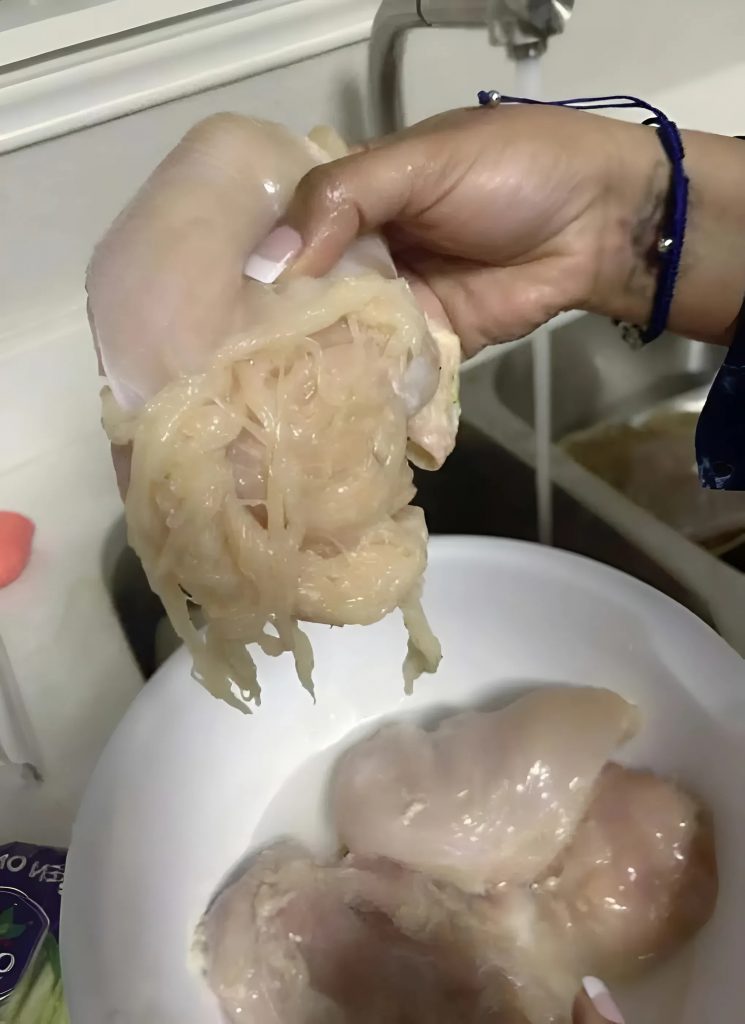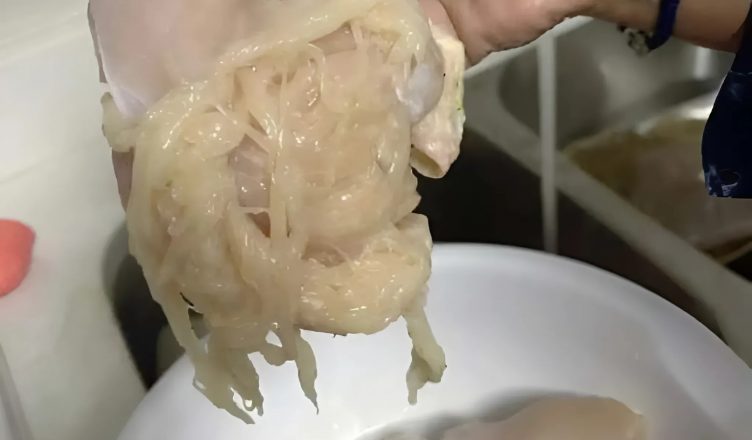Picture an ordinary evening. You’re preparing dinner for your family, just like countless times before. You unwrap a chicken breast, rinse it under cool water, and place it on the cutting board. Routine. Familiar. Nothing unusual — until you notice something… off.
Instead of the typical firm, smooth texture of raw chicken, the meat begins to fall apart in your hands. Not into chunks or strands of muscle, but into long, soft fibers, almost like overcooked spaghetti.
Baffled and slightly disturbed, you take a photo and post it online. Within hours, your image garners hundreds of comments, shares, and reactions. People are shocked, alarmed, confused. What is that? Is it safe to eat? Is it even real chicken?
The answer, as it turns out, is yes — it’s real chicken. And what you’ve encountered has a name:
“Chicken spaghetti syndrome.”
It sounds like a meme, but it’s not. It’s a very real and increasingly common phenomenon — and it says a lot about what’s happening in the modern poultry industry.
The phenomenon: what is “spaghetti chicken”?
The official term for what you’re seeing is “muscle fiber separation,” often referred to colloquially as «chicken spaghettification.” It’s a condition where the meat loses its normal structure and instead takes on a stringy, fibrous texture that crumbles when handled.
It’s not an infection. It’s not rot. It’s not a genetic mutation. It’s something far more industrial.
Scientists and food quality experts have linked this strange texture to modern industrial poultry farming, particularly in broiler chickens bred for fast growth and high muscle yield.
Why it happens: the price of rapid meat production
To meet rising global demand, chickens are now genetically selected and intensively bred to reach slaughter weight in record time — often in just 5 to 6 weeks.
This unnatural pace of growth puts extreme pressure on their bodies. Muscles grow faster than the chicken’s circulatory and metabolic systems can support, leading to poor oxygenation, tissue stress, and structural breakdown.

The result: instead of healthy muscle, you get fibrous, watery, and structurally damaged meat. The tissue has the appearance of cooked noodles. It shreds before cooking. It’s essentially falling apart.
And it’s happening more often than you think.
Is spaghetti chicken dangerous to eat?
Short answer: No, it’s not inherently dangerous — but that doesn’t mean it’s harmless either.
Here’s what you should know:
Nutritionally, the meat is often lower in protein and higher in collagen and water.
It may taste bland, even rubbery, and has a less satisfying texture when cooked.
Cooking it evenly can be more difficult due to inconsistent structure.
It may be an indicator of low-quality production and poor animal welfare.
The meat is still technically edible, and it won’t make you sick. But you’re getting a degraded product sold at full price. That’s the real issue.
How common is this?
Studies have shown that up to 20% of chicken breasts in supermarkets show signs of muscle abnormalities, including:
White striping – white lines of fat through the meat.
Woody breast – unusually hard or rubbery texture.
Spaghetti meat – soft, shredded texture like cooked pasta.
These issues are especially prevalent in cheap, mass-produced chicken. The faster the chicken grows, the higher the risk.
How to spot spaghetti chicken
Here are some visual and physical signs to watch out for:
Shredding before cooking — if the meat pulls apart in fibers just by handling, that’s a red flag.
Lack of firmness — the meat feels mushy or overly soft.
Visible striations or streaks — white lines or discoloration running through the breast.
Uneven texture when cut — flaky or stringy consistency, even before heat is applied.
If in doubt, don’t cook it. And definitely don’t serve it raw or undercooked.
What can you do as a consumer?
While you can’t always avoid industrial chicken, there are steps you can take to reduce your exposure to low-quality meat:
Buy organic or free-range whenever possible — these chickens are usually raised more slowly and in less stressful conditions.
Shop from local butchers or farmers’ markets — and ask about how their poultry is raised.
Check the meat before buying — avoid heavily striated, uneven, or soft-looking cuts.
Speak up — if you encounter spaghetti chicken, report it to the store.
Support transparency — choose brands that clearly label production methods and quality standards.
